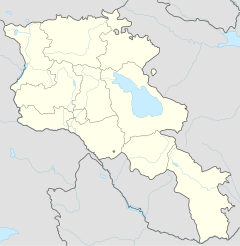Ltschaschen
|
Ltschaschen Լճաշեն |
||
| State : |
|
|
| Province : | Gegharkunik | |
| Coordinates : | 40 ° 31 ' N , 44 ° 56' E | |
| Height : | 1930 m | |
| Residents : | 4,182 (2006) | |
| Time zone : | UTC + 4 | |
|
|
||
Ltschaschen ( Armenian Լճաշեն ; English transcription Lchazhen ) is a village in Armenia with 4182 inhabitants. In the local area there is a Bronze Age cemetery, an Urartian fortress and a church from the 13th century. It is known for its excavation site on the eastern edge of the village, which is considered one of the most important archaeological sites in Armenia.
location
Ltschaschen is located about 50 kilometers northeast of the capital Yerevan in the Eastern Armenian province of Gegharkunik on the shores of Lake Sevan. There the village arose at an altitude of about 1930 meters on the northern edge of the Gegham Mountains .
history
The oldest traces of settlement were found in a Bronze Age cemetery and the adjacent settlement areas. On the southern edge of the cemetery are the remains of an ancient settlement and an Urartean fortress. Its origins date back to the 3rd millennium BC and were discovered in 1950 when the water level of Lake Sevan fell sharply due to Soviet irrigation programs . The village is commonly assigned to the Kura Araxes culture . More recent research results doubt this due to the widely differing findings, for example in the case of burial rituals.
According to the research results so far, Ltschaschen was at the end of the 4th millennium BC. Founded. The fortress was built in the 3rd millennium. Round and angular settlement structures stood within the settlement area. Finds suggest that the economy was based on agriculture, livestock, woodworking, basket weaving, metallurgy, and ceramics. The heyday of Ltschaschen probably lasted from around 1500 BC. Until the fall of the Urartian Empire in the 7th century BC. Chr.
The Bronze Age cemetery
The Bronze Age cemetery is around 800 meters long and 100 meters wide. To date, around 800 graves have been discovered on the site, most of which were covered with stones. They are possibly relics of a unique Bronze Age culture. The grave goods suggest that some of those buried there were members of an elite who were buried in two or four-wheeled horse-drawn carts made of local oak and elm with harnessed horses or bulls. The deceased and other grave goods were placed on the wagons as if they were on their way to the afterlife . The idea of the journey into the hereafter determined the effort for the dead, i.e. for the ancestors. It expresses the need to be able to dispose of earthly wealth in addition to the domesticated horses in the hereafter . The grave goods included bronze bull statues, a golden frog and 25 other gold objects that were made in the 2nd millennium BC. The gold required for this was probably mined in Zod, a village in southern Gegharkunik. The most important finds from Ltschaschen also include multicolored ceramic goods with dotted patterns. They represent a further development of the previously used black, polished ceramic goods. The wooden household items found in the cemetery, such as spoons, ladles, ladles, cups, buckets and tables, provide a glimpse into the everyday life of the Bronze Age villagers.
Ltschaschen's inscription was carved into a rock facing the lake near the cemetery on the left and about 15-20 meters from Sevan Gavar Street. It says that the Urartian king Argišti I conquered the land of Qihu and reached the city of Ištiquni, which may mean Ltschaschen.
Finds from Ltschaschen are shown in the Hermitage ( St. Petersburg ) and in the State Historical Museum in Yerevan .
Web links
Individual evidence
- ↑ a b GeoNames.org. Retrieved November 30, 2017 .
- ↑ a b c d Helix Consulting LLC: Silk Road 4: L'chashen. The L'chashen People. Burial Practices. Artifacts - Silk Road: L'chashen Excavation - Armenian Heritage. Retrieved November 30, 2017 .
- ↑ Г.А. Меликишвили, Урартские клинообразные надписи. Москва: Издательство АН СССР, 1960, No. 134
- ↑ Rediscovering Armenia Guidebook- Gegharkunik Marz - Armeniapedia.org. Retrieved November 30, 2017 .

